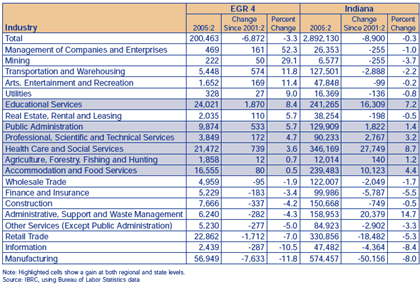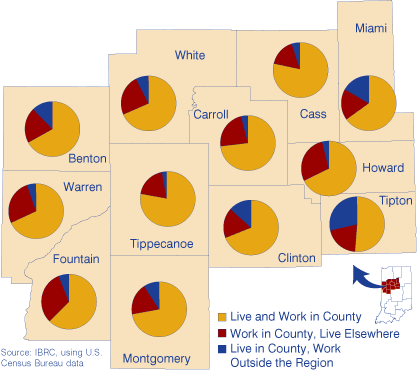Regional Perspective: Economic Growth Region 4
Economic Growth Region (EGR) 4, located in north-central Indiana, includes the following 12 counties: Benton, Carroll, Cass, Clinton, Fountain, Howard, Miami, Montgomery, Tippecanoe, Tipton, Warren and White. This 12-county region covers nearly 4,800 square miles of land, more area than any of the other 10 growth regions, and is home to 482,466 people (or 7.7 percent of all Hoosiers).
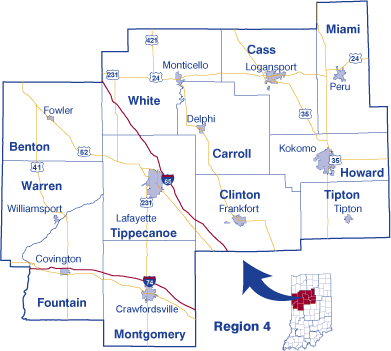
If the population of EGR 4 were distributed evenly by county, each would contain 8.3 percent of the region's residents. As expected, that isn't the case. At the center of the region, Tippecanoe County (home to Purdue University) makes up nearly one-third of the EGR's population. Of all the counties in the region, Cass County comes the closest to making up its fair share with 8.4 percent of the population (see Figure 1). The other nine counties range from 7.9 percent to 1.8 percent.
Figure 1: EGR 4 Population Distribution
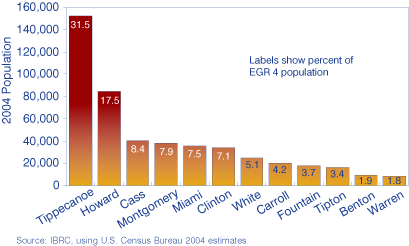
Racial Characteristics
Region 4 shows a slightly different race distribution than the state overall. For example, 94.2 percent of residents in EGR 4 are white, 5.4 percentage points higher than the state average. The region is also home to a higher percentage of Asians (2 percent) than Indiana (1.1 percent), or any of the other growth regions for that matter. This is mainly due to Purdue University in Tippecanoe County. On the other hand, the black population in EGR 4 is considerably less than the state average (by 6.1 percentage points), but remains higher than in EGR 6 and EGR 9.
Jobs
Manufacturing swept away the other 19 major industry classifications as the largest employer in the region, accounting for 28.4 percent of all jobs. With the loss of more than 7,600 manufacturing jobs, this percentage has dropped since the second quarter of 2001, when the manufacturing distribution was 31.1 percent of all jobs in the region (see Table 1).
Table 1: Change in Jobs in EGR 4 and Indiana, 2001:2 to 2005:2
The good news is that 12 of the 20 major industry classifications in the region added jobs from 2001:2 to 2005:2; only seven industries at the state level can say the same. The bad news for EGR 4 is that the job gains weren't nearly high enough to offset the losses in the other eight classifications, due mainly to high losses in the manufacturing and retail trade industries. Overall, EGR 4 lost 6,782 jobs across all industry sectors, compared to the 8,900 jobs lost at the state level. While it appears from these numbers that the region did better than the state, a closer look reveals that jobs in EGR 4 were lost at a relatively faster rate (a 3.3 percent decline) than they were in Indiana (a 0.3 percent decline).
In contrast to Region 3 (discussed in the March issue), the highest percent increases in jobs occurred in the mining and management of companies and enterprises industries; however, similar to Region 3, these industries combined make up a very small percentage of total jobs (only 0.3 percent). Therefore, while those gains were significant at the individual industry level, they did not affect a large number of jobs.
Income and Wages
Wages in every industry in EGR 4 increased from 2001:2 to 2005:2, except for arts, entertainment and recreation, which dropped by a mild $5 per week (see Figure 2). Meanwhile, the state increased wages during that same time period for every major industry classification. However, EGR 4 managed to pull away with a slight lead in increases across all industry sectors. The region's overall increase in weekly wages was $69, while Indiana increased weekly wages by $68.
Figure 2: EGR 4 Change in Average Weekly Wages by Industry, 2001:2 to 2005:2
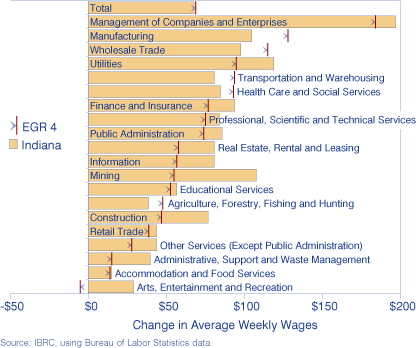
Commuting
Of the 225,975 people who work in the region, 92.8 percent also reside in EGR 4, according to Census 2000. In other words, about 16,200 people live outside the region but commute in to work. Figure 3 shows the county-level commuting patterns for the region.
Figure 3: EGR 4 Commuting, 2000
Locally, Tippecanoe County was the only one of the 12 that contributed workers to all counties in the region. That being said, it wasn't exceedingly generous with the number of workers sent out (only 2,790), ranking sixth of the 12 counties in the region (compare this to Carroll County's contribution of 5,082 workers, nearly half of which went into Tippecanoe County alone—which totaled about 300 workers less than Tippecanoe County's entire contribution to the region). Of those that left Tippecanoe County, 25.9 percent ended up in neighboring Clinton County.
Meanwhile, Howard, Montgomery and Tippecanoe counties brought in more workers than they contributed to the rest of the region. Montgomery County's net gain of 144 workers can be attributed to the fact that it sent out the fewest number of people into the region to work (1,625). As can be expected from the large net gains seen by Howard (about 7,190) and Tippecanoe (just over 11,200) counties, the nine other counties in the region all had net losses of at least 1,000 workers to fellow EGR counties.
Molly
Marlatt, Research Associate
Indiana Business Research Center, Kelley
School of Business, Indiana University

